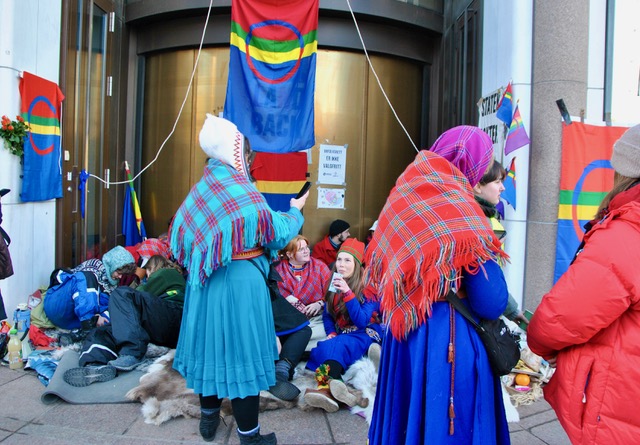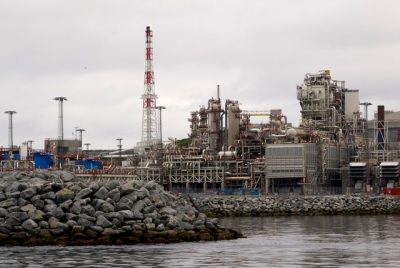NEWS ANALYSIS: As storms blamed on climate change continued to ravage Southern Norway this week, top government officials were in sunny Northern Norway to unveil what Prime Minister Jonas Gahr Støre claims is “the biggest single climate measure decision made by a Norwegian government.” His government’s plans to electrify operations at the Melkøya gas plant off Hammerfest are meant to cut its carbon emissions, but also contain environmentally unfriendly aspects that quickly sparked lots of negative reaction.

Critics immediately complained that electrifying Melkøya, which processes gas from Norway’s offshore Snøhvit (Snow White) 90 kilometers away, will also help sustain Norway’s highly profitable oil and gas industry that climate and environmental advocates want to rein in and ultimately shut down. The electrification project will also require construction of both hotly contended power lines and wind turbines, to provide the electricity Melkøya will need without raising electricity rates for everyone else in the area.
Conflicts thus loom on a variety of fronts, because power lines and wind turbines tend to harm the nature where they’re erected. The turbines also disturb reindeer herding, and reaction from Norway’s indigenous Sami people was swift. They’re already deeply offended over the wind turbines built farther south in Fosen that were ruled invalid by Norway’s own Supreme Court but remain standing, setting off huge protests in Oslo last winter and spring.
“This is a scandal, and I’m shocked to hear about it in this manner,” Sami activist and politician Maja Kristine Jåma told Norwegian Broadcasting (NRK) just after Støre and his colleagues went public with their plans. She claimed Sami representatives were excluded from the planning process: “We had great expectations that we’d be kept informed and consulted on this issue. We have sought consultations and haven’t heard back. There’s no question this is not building up confidence in (government) processes, or the promises we’ve had about more involvement and stronger dialogue.”

Jåma had lots of support from others, even the Green Party’s Lan Marie Berg. “I fear this will be a new Fosen,” said Berg, referring to this spring’s massive demonstrations against the wind turbines that the Supreme Court claims have violated the Samis’ human rights. Berg acknowledges the need for more electricity generation and “some” controversial turbines on land, “but we’re worried this can happen without a proper plan for preserving nature and Sami rights.”
Jåma also scoffed at the government’s attempt to put a positive spin on plans bound to spark more protests. “Portraying this as good news makes me nothing less than nauseated,” she told NRK. “It’s alarming that the government puts this forth without seeming to reflect over the consequences for the Sami.”
Oil & Energy Minister Terje Aasland, who had to deal with all the demonstrations earlier this year, once again promised “good cooperation with Sami interests” despite few signs of it so far. “We don’t want new conflicts,” he told news bureau NTB, after also stating that the government “will try to minimize” any that arise with the Sami. “We have new opportunities here,” he said.
‘Energy and industrial boost for Finnmark’
Støre was also stressing the positive when he, Aasland and an unusually dour Finance Minister Trygve Slagsvold Vedum of the Center Party unveiled what they branded as “an energy and industrial boost for Finnmark.” They described it all as a means of further economic development for the entire northern region of Finnmark, claiming that a lack of power grid capacity and a limited power situation “is one of the biggest barriers to growth and development in Finnmark.”

The government’s official statement on the issue went on to label the “Snøhvit Future Project” as a catalyst for “a plan for considerable expansion of energy production and networks in Finnmark.”
While Støre’s government and most earlier government have been criticized for failing to cut emissions, top politicians were also once again being accused of giving in to what state oil company Equinor wants, instead of what’s best for the climate. When it was still called Statoil, Equinor succeeded in halting expensive carbon capture and storage (CCS) projects at its Mongstad refinery in Southern Norway. Now it seems to have halted CCS at Melkøya, too, with Støre telling NRK that “we evaluated it” but decided it was “much more expensive.” Electrification was thus deemed the best option, even though electricity supplies will need to be greatly increased.
Opposition to the plan also came on Tuesday from the Socialist Left Party (SV), on which Støre’s Labour-Center government usually relies for a a majority in Parliament. SV’s Lars Haltbrekken, a former leader of Norway’s chapter of Friends of the Earth, agrees that emissions at Melkøya must be cut, but SV wanted a CCS project. “The solution the government has chosen will lead to huge environmental damage and major conflicts with reindeer herding that could have been avoided,” Haltbrekken told newspaper Dagens Næringsliv (DN).
He also questions whether emissions will actually be cut, since the electrification of Melkøya won’t begin until 2030, instead of an earlier proposal for 2028. If wind turbine and other power projects are delayed, there won’t be the electricity needed and Melkøya will continue to spew carbon into the atmosphere.
Only the Conservative Party came forth as supporting the Melkøya electrification plan. The Liberal, Progress, Reds and Christian Democrats parties joined SV and the Greens in opposing the electrification project, but since it’s budgeted to cost less than NOK 15 billion, formal approval from Parliament isn’t needed. The conservative Progress Party fears residents of Finnmark will wind up with “sky-high” electricity bills and conflicts. So does the Reds Party, which also called the plan “a new attack on Norway’s Sami population.”
Split the government
Many members of Finance Minister Vedum’s own Center Party are also upset, since Center actually voted against electrification of Melkøya at its last national meeting. The head of the Center Party’s youth organization Senterungdommen, Andrine Hanssen-Seppola, was angry with her own party leader (Vedum) over the electrification plans, claiming “it will tap all of Northern Norway for power” and send elecricity rates soaring for other businesses and residents in the region.
Some Center Party officials in Finnmark were even threatening to withdraw their party membership over the issue, and weren’t looking forward to meeting furious voters ahead of upcoming municipal elections in September. Calls came Tuesday for Center to “re-evaluate its government cooperation,” and perhaps even drop out of its coalition with Støre’s Labour Party.

The internal opposition can explain why Vedum wasn’t his usual jovial self when the plans were rolled out in Hammerfest on Tuesday. He defended the electrification plans, to which he clearly had conceded, said it was “important” to put in place major expansion of Finnmark’s electricity network, not least a new 420kv power line from Balsfjord in Troms to Skaidi in Finnmark and on to Hammerfest. “We need more power and more cables to transport it,” he said. He admitted the issue was difficult and “demanding,” but “incredibly important.”
Public authorities in charge of expanding the grid have in turn promised to speed up the approval process for new turbine and power line projects, even as Aasland claimed evaluation of energy projects would remain “thorough” and that the final result “can’t be predicted.”
NewsinEnglish.no/Nina Berglund

